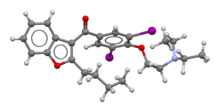
Back أميودارون Arabic آمیودارون AZB Amiodarona Catalan Amiodaron Welsh Amiodaron German Αμιωδαρόνη Greek Amiodarona Spanish Amiodaroon Estonian آمیودارون Persian Amiodaroni Finnish
 | |
 | |
| Clinical data | |
|---|---|
| Pronunciation | /ˌæmiˈoʊdəroʊn/ or /əˈmiːoʊdəˌroʊn/ |
| Trade names | Cordarone, Nexterone, Pacerone, others |
| AHFS/Drugs.com | Monograph |
| MedlinePlus | a687009 |
| License data |
|
| Pregnancy category |
|
| Routes of administration | By mouth, intravenous, intraosseous |
| ATC code | |
| Legal status | |
| Legal status | |
| Pharmacokinetic data | |
| Bioavailability | 20–55% |
| Protein binding | 96% |
| Metabolism | Liver |
| Elimination half-life | 58 d (range 15–142 d) |
| Excretion | Primarily liver and bile |
| Identifiers | |
| |
| CAS Number | |
| PubChem CID | |
| IUPHAR/BPS | |
| DrugBank | |
| ChemSpider | |
| UNII | |
| KEGG | |
| ChEBI | |
| ChEMBL | |
| CompTox Dashboard (EPA) | |
| ECHA InfoCard | 100.016.157 |
| Chemical and physical data | |
| Formula | C25H29I2NO3 |
| Molar mass | 645.320 g·mol−1 |
| 3D model (JSmol) | |
| |
| |
| (verify) | |
Amiodarone is an antiarrhythmic medication used to treat and prevent a number of types of cardiac dysrhythmias.[4] This includes ventricular tachycardia, ventricular fibrillation, and wide complex tachycardia, atrial fibrillation, and paroxysmal supraventricular tachycardia.[4] Evidence in cardiac arrest, however, is poor.[5] It can be given by mouth, intravenously, or intraosseously.[4] When used by mouth, it can take a few weeks for effects to begin.[4][6]
Common side effects include feeling tired, tremor, nausea, and constipation.[4] As amiodarone can have serious side effects, it is mainly recommended only for significant ventricular arrhythmias.[4] Serious side effects include lung toxicity[7] such as interstitial pneumonitis, liver problems, heart arrhythmias, vision problems, thyroid problems, and death.[4] If taken during pregnancy or breastfeeding it can cause problems in the fetus or the infant.[4] It is a class III antiarrhythmic medication.[4] It works partly by increasing the time before a heart cell can contract again.[4][6]
Amiodarone was first made in 1961 and came into medical use in 1962 for chest pain believed to be related to the heart.[8] It was pulled from the market in 1967 due to side effects.[9] In 1974 it was found to be useful for arrhythmias and reintroduced.[9] It is on the World Health Organization's List of Essential Medicines.[10] It is available as a generic medication.[4] In 2021, it was the 235th most commonly prescribed medication in the United States, with more than 1 million prescriptions.[11][12][6]
- ^ "Pacerone- amiodarone hydrochloride tablet". DailyMed. Archived from the original on 29 December 2022. Retrieved 8 September 2021.
- ^ "Cordarone (amiodarone) tablets, for oral use Initial U.S. Approval: 1985". DailyMed. 30 October 2018. Archived from the original on 29 December 2022. Retrieved 8 September 2021.
- ^ "Nexterone- Amiodarone HCl injection, solution". DailyMed. Archived from the original on 29 December 2022. Retrieved 8 September 2021.
- ^ a b c d e f g h i j k "Amiodarone Hydrochloride". The American Society of Health-System Pharmacists. Archived from the original on 19 September 2016. Retrieved 22 August 2016.
- ^ Ali MU, Fitzpatrick-Lewis D, Kenny M, Raina P, Atkins DL, Soar J, et al. (November 2018). "Effectiveness of antiarrhythmic drugs for shockable cardiac arrest: A systematic review" (PDF). Resuscitation. 132: 63–72. doi:10.1016/j.resuscitation.2018.08.025. PMID 30179691. S2CID 52154562. Archived (PDF) from the original on 5 March 2020. Retrieved 17 December 2019.
- ^ a b c Review of the Medical Use of Amiodarone (Nexterone, Pacerone). Xavier Research Press. 24 July 2018. ISBN 978-1-7242-7798-5.
- ^ Feduska ET, Thoma BN, Torjman MC, Goldhammer JE (May 2021). "Acute Amiodarone Pulmonary Toxicity". J Cardiothorac Vasc Anesth. 35 (5): 1485–1494. doi:10.1053/j.jvca.2020.10.060. PMID 33262034. S2CID 227253264.
- ^ Analytical Profiles of Drug Substances and Excipients. Academic Press. 1992. p. 4. ISBN 978-0-08-086115-9. Archived from the original on 8 September 2017.
- ^ a b Fischer J, Ganellin CR (2005). Analogue-based Drug Discovery. John Wiley & Sons. p. 12. ISBN 978-3-527-60749-5. Archived from the original on 8 September 2017.
- ^ World Health Organization (2019). World Health Organization model list of essential medicines: 21st list 2019. Geneva: World Health Organization. hdl:10665/325771. WHO/MVP/EMP/IAU/2019.06. License: CC BY-NC-SA 3.0 IGO.
- ^ "The Top 300 of 2021". ClinCalc. Archived from the original on 15 January 2024. Retrieved 14 January 2024.
- ^ "Amiodarone - Drug Usage Statistics". ClinCalc. Archived from the original on 18 January 2024. Retrieved 14 January 2024.
© MMXXIII Rich X Search. We shall prevail. All rights reserved. Rich X Search